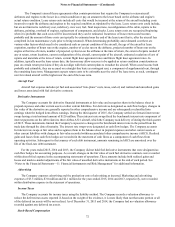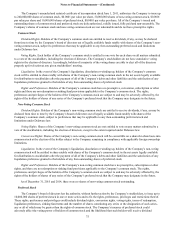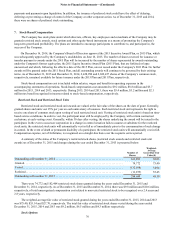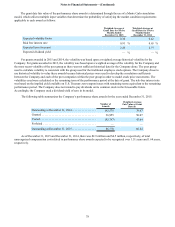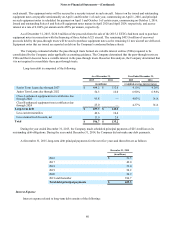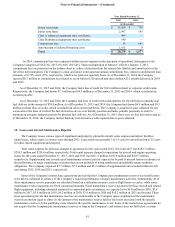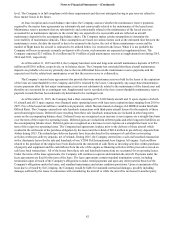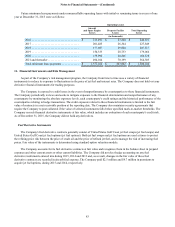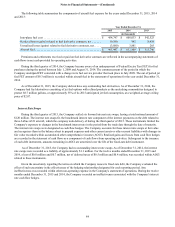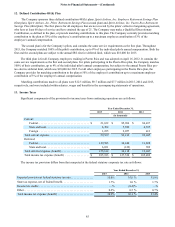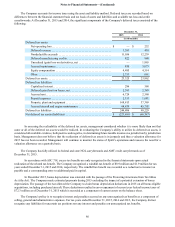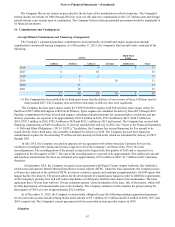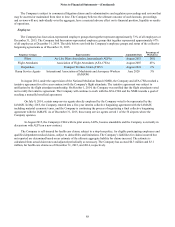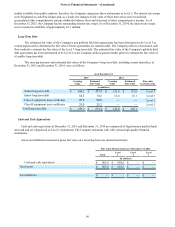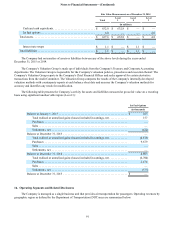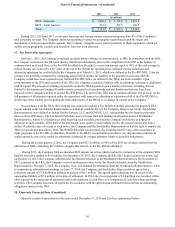Spirit Airlines 2015 Annual Report Download - page 82
Download and view the complete annual report
Please find page 82 of the 2015 Spirit Airlines annual report below. You can navigate through the pages in the report by either clicking on the pages listed below, or by using the keyword search tool below to find specific information within the annual report.Notes to Financial Statements—(Continued)
82
level. The Company is in full compliance with those requirements and does not anticipate having to pay reserves related to
these master leases in the future.
At lease inception and at each balance sheet date, the Company assesses whether the maintenance reserve payments
required by the master lease agreements are substantively and contractually related to the maintenance of the leased asset.
Maintenance reserve payments that are substantively and contractually related to the maintenance of the leased asset are
accounted for as maintenance deposits to the extent they are expected to be recoverable and are reflected as aircraft
maintenance deposits in the accompanying balance sheets. The Company makes certain assumptions to determine the
recoverability of maintenance deposits. These assumptions are based on various factors such as the estimated time between the
maintenance events, the date the aircraft is due to be returned to the lessor, the cost of future maintenance events and the
number of flight hours the aircraft is estimated to be utilized before it is returned to the lessor. When it is not probable the
Company will recover amounts currently on deposit with a lessor, such amounts are expensed as supplemental rent. The
Company expensed $2.3 million, $1.6 million and $1.9 million of paid maintenance reserves as supplemental rent during 2015,
2014 and 2013, respectively.
As of December 31, 2015 and 2014, the Company had short-term and long-term aircraft maintenance deposits of $279.9
million and $250.0 million, respectively, on its balance sheets. The Company has concluded that these aircraft maintenance
deposits are probable of recovery primarily due to the rate differential between the maintenance reserve payments and the
expected cost for the related next maintenance event that the reserves serve to collateralize.
The Company’s master lease agreements also provide that some maintenance reserves held by the lessor at the expiration
of the lease are nonrefundable to the Company and will be retained by the lessor. Consequently, any usage-based maintenance
reserve payments after the last major maintenance event are not substantively related to the maintenance of the leased asset and
therefore are accounted for as contingent rent. Supplemental rent is recorded at the time a non-refundable maintenance reserve
payment is made that has been substantively determined to be contingent rent.
As of December 31, 2015, the Company had a fleet consisting of 79 A320 family aircraft and 11 spare engines of which
61 aircraft and all 11 spare engines were financed under operating leases with lease term expiration dates ranging from 2016 to
2027. Five of the leased aircraft have variable rent payments, which fluctuate based on changes in LIBOR (London Interbank
Offered Rate). The Company entered into sale leaseback transactions with third-party aircraft lessors for the majority of these
aircraft and engine leases. Deferred losses resulting from these sale leaseback transactions are included in other long-term
assets on the accompanying balance sheet. Deferred losses are recognized as an increase to rent expense on a straight-line basis
over the term of the respective operating leases. Deferred gains are included in deferred gains and other long-term liabilities on
the accompanying balance sheet. Deferred gains are recognized as a decrease to rent expense on a straight-line basis over the
term of the respective operating leases. The Company had agreements in place prior to the delivery of these aircraft which
resulted in the settlement of the purchase obligation by the lessor and the refund of $48.4 million in pre-delivery deposits from
Airbus during 2015. The refunded pre-delivery deposits have been disclosed in the statement of cash flows as investing
activities within pre-delivery deposits, net of refunds. During 2015, the Company entered into a sale and leaseback transaction
with a third-party lessor for the sale and leaseback of one V2500 IAE International Aero Engines AG engine. Cash outflows
related to the purchase of the engine have been disclosed in the statement of cash flows as investing activities within purchases
of property and equipment and the cash inflows from the sale of the engine as financing activities within proceeds received on
sale lease back transactions. All of the leases from these sale and leaseback transactions are accounted for as operating leases.
Under the terms of the lease agreements, the Company will continue to operate and maintain the aircraft. Payments under the
lease agreements are fixed for the term of the lease. The lease agreements contain standard termination events, including
termination upon a breach of the Company's obligations to make rental payments and upon any other material breach of the
Company's obligations under the leases, and standard maintenance and return condition provisions. Upon a termination of the
lease due to a breach by the Company, the Company would be liable for standard contractual damages, possibly including
damages suffered by the lessor in connection with remarketing the aircraft or while the aircraft is not leased to another party.


